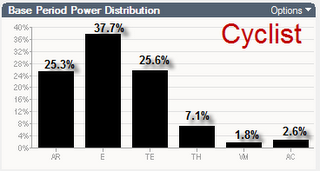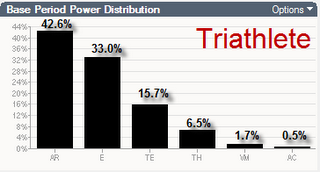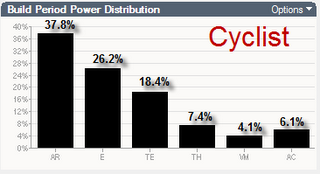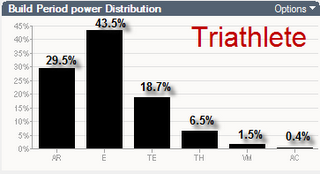Build Period Specificity
As you start the Build period of training following a successful Base period your training intensity and duration should become more like the event for which you are training. The Base period is not nearly so specific to the demands of racing. In the Base period there is even a lot of similarity between what a road cyclist and an Ironman triathlete do in training. But by the Build period the training for these two sports is considerably different since the demands of the races have little in common. Let’s examine this more closely with some examples from these two sports. Here you see the bicycle power distributions by zones from the Base period for a competitive road cyclist and an Ironman triathlete. Each zone is labeled with its percentage of the total training time during te Base period. Both are very successful age-group athletes I coach and both Base charts are from their 2009 winter training. The power zones on these charts follow the Coggan system commonly used in WKO+ software. I’ve renamed the zones as follows:
Here you see the bicycle power distributions by zones from the Base period for a competitive road cyclist and an Ironman triathlete. Each zone is labeled with its percentage of the total training time during te Base period. Both are very successful age-group athletes I coach and both Base charts are from their 2009 winter training. The power zones on these charts follow the Coggan system commonly used in WKO+ software. I’ve renamed the zones as follows: Zone 1. AR – Active Recovery. Less than 56% of Functional Threshold power (FTP). FTP is similar to the lactate threshold inetnsity discussed in my books.
Zone 1. AR – Active Recovery. Less than 56% of Functional Threshold power (FTP). FTP is similar to the lactate threshold inetnsity discussed in my books.
Zone 2. E – Endurance. 56-75% of FTP. Used for aerobic endurance training. The intensity at which an Ironman Triathlon is typically raced.
Zone 3. TE – Tempo. 76-90% of FTP. A moderately hard effort. Equivalent to half iron racing intensity and also to riding in a fast moving pack in a road race.
Zone 4. TH – Threshold. 91-105% of FTP. A hard effort sustainable for roughly an hour. At 100% of FTP you are riding at CP60 – the critical power you could maintain for 60 minutes. This is the intensity at which you begin to redline.
Zone 5. VM – VO2max. 106-120% of FTP. The upper end of this zone is sustainable for about 6 minutes depending on how anaerobically fit you are. This intensity often determines the outcomes of bike road races on hills, when there are breakaways, and in cross winds.
Zone 6. AC – Anaerobic Capacity. Greater than 120% of FTP. Again, this intensity is common in road racing, but is never a factor in non-drafting triathlons.
While there are obvious small differences, if we simply look at how much training was done in the three lowest zones (1-AR, 2-E, 3-TE) we find that the cyclist spent 88.5% of his Base period intensity there and the triathlete 91.3%. And, conversely, the cyclist trained for 11.5% of his Base in the three upper zones (4-TH, 5-VM, 6-AC) with the triathlete getting 8.7% of training time there. Again, there is not a lot of difference in the intensity spread even though the sports are so drastically different. But in these Build period charts you see a rather significant shift in training intensities from those of the Base. In the cyclist’s chart two things are obvious: He increased his upper zones training time by half, and he increased his zone 1 (AR) time by about half also. The greater intensity appears to have required more active recovery time. I usually see a very similar shift for road cyclists as they move into the Build period. They simply need to rest more because of the more stressful, redline workouts. Notice also that the cyclist’s zone 3 (TE) time decreased by nearly a third from the Base period. This is often referred to as “No Man’s Land” by coaches and athletes. Build is the seasonal period when that moniker is best applied. There is a lot of value to zone 3 training in the early Base period for road cyclists.
But in these Build period charts you see a rather significant shift in training intensities from those of the Base. In the cyclist’s chart two things are obvious: He increased his upper zones training time by half, and he increased his zone 1 (AR) time by about half also. The greater intensity appears to have required more active recovery time. I usually see a very similar shift for road cyclists as they move into the Build period. They simply need to rest more because of the more stressful, redline workouts. Notice also that the cyclist’s zone 3 (TE) time decreased by nearly a third from the Base period. This is often referred to as “No Man’s Land” by coaches and athletes. Build is the seasonal period when that moniker is best applied. There is a lot of value to zone 3 training in the early Base period for road cyclists. The Build period shift in training intensities from the higher zones to the lower was less pronounced for the triathlete. He went from 8.7% in the three upper zones in Base to 8.4% in Build. Not much. The most obvious shift here was from zone 1 (AR) in Base to zone 2 (E) in Build. AR decreased by nearly a third while E increased by about the same amount. What this tells us is that training in zone 2, while necessary for success in an Ironman Triathlon, is not nearly as stressful as upper zone intensity training was for the cyclist.
The Build period shift in training intensities from the higher zones to the lower was less pronounced for the triathlete. He went from 8.7% in the three upper zones in Base to 8.4% in Build. Not much. The most obvious shift here was from zone 1 (AR) in Base to zone 2 (E) in Build. AR decreased by nearly a third while E increased by about the same amount. What this tells us is that training in zone 2, while necessary for success in an Ironman Triathlon, is not nearly as stressful as upper zone intensity training was for the cyclist.
The bottom line to all of this is that the closer you get in time to your A-priority race, the more like the race your training must become. In road cycling, races are determined by how one reacts when the intensity is very high. Therefore the road cyclist’s zones 4, 5 and 6 training increased significantly in Build while he also increased his zone 1 to recover from all of the stress. The Ironman triathlete’s intensity shifted from zone 1 to zone 2 since his race at that distance will be raced mostly in upper zone 2 with short bouts in zone 3 on hills.
The question you must ask yourself at this time of the season is, “Am I making my workouts increasingly like my next A-priority race?” With all of the technology we now have available you can measure this quite accurately. But even without training gizmos you should be able to gauge how your effort is being distributed as the season progresses.


13 Comments:
great post Joe,
I have always used intensity (ie zone 2) as a % of my overall weekly volume.
During the base period I will target 30% of my weekly volume in zone 2 and then in hte build period I will target 50% of my weekly volume in zone 2.
If i can't meet those % then I'll adjust my volume so that I can. I find this helps determine my optimal volume of training for each training cycle.
Thanks for sharing
Cheers
Paul F
Hi Joe, I wonder how can someone have such low percentage in the AR zone, when all soft pedaling and just rolling in the field counts to that? In my profile it is way the highest bar, 40%.
Adept--You must be referring to the triathlete in Build. Notice that 73% of his time is in Z1 and 2. Much of this will be in low Z2 which isn't particularly stressful. He typically rides 5 times/week with 2 of them being easy, recovery and also on the short side. So 3 each week are Z2 or higher for the most part. Of course, there will be a lot of variation in how these charts look for different athletes. But if you are training for IM you will have a lot of time in the lower 3 zones in the Build period. He has about 92% there.
Joe, sometimes it's strange to go for a 120 minutes workout (cycling), do five 3 minutes intervals with its rest periods and then...what should I do during the rest of the time? Stay in Z2, Z3??
Would you suggest combining workouts on hard days? If so, what are your favorite selections based on your book codes (eg. A1 + M1)?
Thanks, Fabiano.
I'd be interested in seeing the same charts for an Olympic distance triathlete.
-Mike.
Fabiano--I try to schedule workouts with lots of sets for longer workouts and those with shorter sets for shorter workouts. But if doing 5x3 within a 2h ride I'd do long warm, long cool down and perhaps another ability combined with it, such as E2 in Base, M1 in Base, or M5 or M6 in Build. See appendices in my training bibles for what there entail. In Build i almost alsways combine abilities. Which ones are combined depends on your sport (triathlon, roadie, MT, runner, etc) and limiters.
Hi Mike--Sorry, but not coaching any Oly-tri right now. And the ones I have coached in the past I don't have the files for now. I'm in Boulder for the summer.
Hi Joe,
What kind of volumes are these riders doing? I ask because the % in the TH zone during base and build is fairly low compared to my numbers. I have a limited amount of time to train (max 8-10 hours a week on the bike) so I try to pack in as much intensity as I can.
I seem to be able to sustain this with an avergae weekly IF of 0.85. So far this season I have spent 17% of my time in TH. I'm confident my FTP is correct etc so that isn't throwing my numbers out.
I am guessing your example riders have more time on their hands so the proportion of TH work goes down.
Mark
Hi Mark--Good question. The fewer the hours, the higher the intensity is likely to be as you suggest. The cyclist is doing about 600 annual hours and the triathlete about 800.
Joe -
Is it fair to say a triathlete should see an increasing amount of time in tempo/z3 during the build phase if their A race is a HIM?
This goes against the "no man's land" moniker but am I correct in assessing that this is OK based on the goal?
Thanks,
-Tim
Hi Tim--Yes, i agree with you on the zone 3 thing.
Hi Joe,
I try to tailor my training to my races, but I've noticed a specific problem coming up that I think I need to addressed through more specification in my training. I focus on 100km+ road races with a lot of climbing. I often fade slightly near the end (get dropped by the group), but somehow manage to fight my way back back after a few minutes. My last race is an example; a 170km race with three categorizable climbs. The last climb at around 150 km (3km @ 8%) required a full out effort to stay with a breakaway group of 20. When we hit the false flat at the top, I couldn't keep pace after a couple of kilometers and had to drop off the back of the group. However, I managed to stay about 50 meters behind them holding the same speed until I recoved enough to increase speed and join them again (after about 5 minutes).
Do you know why this might happen? Why do I fall off the group, only to hold the same speed some meters back? This has happened several times. Another strange aspect is that at the end, I sometimes have enough energy to give a sprint a shot.
Regards,
Mark
P.S. I tend to be above average on climbs in relation to comparable level riders and I'm able to keep up the pace in the chain gang (though, it's not a strength). My body is more climber build than time trialer and I focus on endurance and climbing in my training. Also, I'm fairly consistent with eating and drinking during races.
Hi Mark--That's a tough one to answer. Sounds like if you can improve here then you will be very competitive. But even when I've been coaching someone for a long time such things can be difficult to determine. It could be how you distribute the expenditure of energy during the race. But if it's physically trainable then my guess is anaerobic endurance or muscular endurance or both. See my book for how to train these. Whichever it is it sounds like you will need to do the high intensity training late in the workout. Of course, if you are racing frequently enough then the races may serve as training. Good luck!
Post a Comment
<< Home